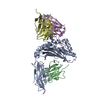[English] 日本語
 Yorodumi
Yorodumi- EMDB-70124: Structure of a synthetic antibody (RM010) in complex with a class... -
+ Open data
Open data
- Basic information
Basic information
| Entry |  | |||||||||
|---|---|---|---|---|---|---|---|---|---|---|
| Title | Structure of a synthetic antibody (RM010) in complex with a class I MHC presenting a hapten-peptide conjugate | |||||||||
 Map data Map data | ||||||||||
 Sample Sample |
| |||||||||
 Keywords Keywords | Complex / Fab / IMMUNE SYSTEM | |||||||||
| Function / homology |  Function and homology information Function and homology informationresponse to mineralocorticoid / GMP binding / forebrain astrocyte development / LRR domain binding / regulation of synaptic transmission, GABAergic / negative regulation of epithelial cell differentiation / response to isolation stress / response to gravity / epithelial tube branching involved in lung morphogenesis / type I pneumocyte differentiation ...response to mineralocorticoid / GMP binding / forebrain astrocyte development / LRR domain binding / regulation of synaptic transmission, GABAergic / negative regulation of epithelial cell differentiation / response to isolation stress / response to gravity / epithelial tube branching involved in lung morphogenesis / type I pneumocyte differentiation / Rac protein signal transduction / positive regulation of Rac protein signal transduction / antigen processing and presentation of peptide antigen via MHC class I / Signaling by RAS GAP mutants / Signaling by RAS GTPase mutants / Activation of RAS in B cells / myoblast proliferation / skeletal muscle cell differentiation / RAS signaling downstream of NF1 loss-of-function variants / RUNX3 regulates p14-ARF / positive regulation of glial cell proliferation / SOS-mediated signalling / Activated NTRK3 signals through RAS / Activated NTRK2 signals through RAS / SHC1 events in ERBB4 signaling / cardiac muscle cell proliferation / Signalling to RAS / Activated NTRK2 signals through FRS2 and FRS3 / SHC-related events triggered by IGF1R / Estrogen-stimulated signaling through PRKCZ / glial cell proliferation / SHC-mediated cascade:FGFR3 / MET activates RAS signaling / SHC-mediated cascade:FGFR2 / PTK6 Regulates RHO GTPases, RAS GTPase and MAP kinases / Signaling by PDGFRA transmembrane, juxtamembrane and kinase domain mutants / Signaling by PDGFRA extracellular domain mutants / SHC-mediated cascade:FGFR4 / Erythropoietin activates RAS / SHC-mediated cascade:FGFR1 / Signaling by FGFR4 in disease / FRS-mediated FGFR3 signaling / Signaling by CSF3 (G-CSF) / Signaling by FLT3 ITD and TKD mutants / FRS-mediated FGFR2 signaling / FRS-mediated FGFR4 signaling / FRS-mediated FGFR1 signaling / p38MAPK events / Signaling by FGFR3 in disease / protein-membrane adaptor activity / Tie2 Signaling / striated muscle cell differentiation / Signaling by FGFR2 in disease / GRB2 events in EGFR signaling / Signaling by FLT3 fusion proteins / SHC1 events in EGFR signaling / FLT3 Signaling / Signaling by FGFR1 in disease / EGFR Transactivation by Gastrin / NCAM signaling for neurite out-growth / CD209 (DC-SIGN) signaling / homeostasis of number of cells within a tissue / Downstream signal transduction / GRB2 events in ERBB2 signaling / Insulin receptor signalling cascade / Ras activation upon Ca2+ influx through NMDA receptor / SHC1 events in ERBB2 signaling / response to glucocorticoid / Constitutive Signaling by Overexpressed ERBB2 / Signaling by phosphorylated juxtamembrane, extracellular and kinase domain KIT mutants / VEGFR2 mediated cell proliferation / small monomeric GTPase / lumenal side of endoplasmic reticulum membrane / FCERI mediated MAPK activation / liver development / ER to Golgi transport vesicle membrane / female pregnancy / RAF activation / Signaling by ERBB2 TMD/JMD mutants / Signaling by SCF-KIT / Constitutive Signaling by EGFRvIII / Signaling by high-kinase activity BRAF mutants / regulation of long-term neuronal synaptic plasticity / MAP2K and MAPK activation / Signaling by ERBB2 ECD mutants / visual learning / Signaling by ERBB2 KD Mutants / MHC class I protein complex / cytoplasmic side of plasma membrane / phagocytic vesicle membrane / recycling endosome membrane / cytokine-mediated signaling pathway / Regulation of RAS by GAPs / Signaling by CSF1 (M-CSF) in myeloid cells / RAS processing / Negative regulation of MAPK pathway / Signaling by RAF1 mutants / Signaling by moderate kinase activity BRAF mutants / Paradoxical activation of RAF signaling by kinase inactive BRAF / Signaling downstream of RAS mutants Similarity search - Function | |||||||||
| Biological species |  Homo sapiens (human) Homo sapiens (human) | |||||||||
| Method | single particle reconstruction / cryo EM / Resolution: 2.88 Å | |||||||||
 Authors Authors | Hu Z / Rajak E / Maso L / Koide S | |||||||||
| Funding support |  United States, 1 items United States, 1 items
| |||||||||
 Citation Citation |  Journal: Proc Natl Acad Sci U S A / Year: 2025 Journal: Proc Natl Acad Sci U S A / Year: 2025Title: Generation of actionable, cancer-specific neoantigens from KRAS(G12C) with adagrasib. Authors: Lorenzo Maso / Epsa Rajak / Takamitsu Hattori / Zhengshan Hu / Akiko Koide / Benjamin G Neel / Shohei Koide /  Abstract: Effective immune therapy against cancer ideally should target a cancer-specific antigen, an antigen that is present exclusively in cancer cells. However, there is a paucity of cancer-specific ...Effective immune therapy against cancer ideally should target a cancer-specific antigen, an antigen that is present exclusively in cancer cells. However, there is a paucity of cancer-specific antigens that are endogenously produced. HapImmune™ technology utilizes covalent inhibitors directed to an intracellular cancer driver to create cancer-specific neoantigens in the form of drug-peptide conjugates presented by class I MHC molecules. Our previous study with sotorasib, an FDA-approved covalent inhibitor of KRAS(G12C), demonstrated that drug-treated cells produce such neoantigens and can be killed by T cell engagers directed against the drug-peptide/MHC complex. Thus, this technology can unite targeted and immune therapies. In the present study, we examined whether this approach could generalize to another FDA-approved KRAS(G12C) inhibitor, adagrasib, whose chemical structure and cysteine reactivity differ substantially from sotorasib. We developed antibodies selective to adagrasib-KRAS(G12C) peptides presented by HLA-A*03 and A*11 that also show cross-reactivity to other KRAS(G12C) inhibitors presented in the same manner. Cryoelectron microscopy structures revealed a mode of adagrasib-peptide/HLA recognition distinctly different from that of sotorasib-directed HapImmune antibodies. The antibodies in a bispecific T cell engager format killed adagrasib-resistant lung cancer cells upon adagrasib treatment. These results support the broad applicability of the HapImmune approach for creating actionable cancer-specific neoantigens and offer candidates for therapeutic development. | |||||||||
| History |
|
- Structure visualization
Structure visualization
| Supplemental images |
|---|
- Downloads & links
Downloads & links
-EMDB archive
| Map data |  emd_70124.map.gz emd_70124.map.gz | 141.4 MB |  EMDB map data format EMDB map data format | |
|---|---|---|---|---|
| Header (meta data) |  emd-70124-v30.xml emd-70124-v30.xml emd-70124.xml emd-70124.xml | 20.6 KB 20.6 KB | Display Display |  EMDB header EMDB header |
| FSC (resolution estimation) |  emd_70124_fsc.xml emd_70124_fsc.xml | 11.2 KB | Display |  FSC data file FSC data file |
| Images |  emd_70124.png emd_70124.png | 97.2 KB | ||
| Filedesc metadata |  emd-70124.cif.gz emd-70124.cif.gz | 6.2 KB | ||
| Others |  emd_70124_half_map_1.map.gz emd_70124_half_map_1.map.gz emd_70124_half_map_2.map.gz emd_70124_half_map_2.map.gz | 139 MB 139 MB | ||
| Archive directory |  http://ftp.pdbj.org/pub/emdb/structures/EMD-70124 http://ftp.pdbj.org/pub/emdb/structures/EMD-70124 ftp://ftp.pdbj.org/pub/emdb/structures/EMD-70124 ftp://ftp.pdbj.org/pub/emdb/structures/EMD-70124 | HTTPS FTP |
-Validation report
| Summary document |  emd_70124_validation.pdf.gz emd_70124_validation.pdf.gz | 977.3 KB | Display |  EMDB validaton report EMDB validaton report |
|---|---|---|---|---|
| Full document |  emd_70124_full_validation.pdf.gz emd_70124_full_validation.pdf.gz | 976.8 KB | Display | |
| Data in XML |  emd_70124_validation.xml.gz emd_70124_validation.xml.gz | 19.9 KB | Display | |
| Data in CIF |  emd_70124_validation.cif.gz emd_70124_validation.cif.gz | 25.8 KB | Display | |
| Arichive directory |  https://ftp.pdbj.org/pub/emdb/validation_reports/EMD-70124 https://ftp.pdbj.org/pub/emdb/validation_reports/EMD-70124 ftp://ftp.pdbj.org/pub/emdb/validation_reports/EMD-70124 ftp://ftp.pdbj.org/pub/emdb/validation_reports/EMD-70124 | HTTPS FTP |
-Related structure data
| Related structure data |  9o55MC M: atomic model generated by this map C: citing same article ( |
|---|---|
| Similar structure data | Similarity search - Function & homology  F&H Search F&H Search |
- Links
Links
| EMDB pages |  EMDB (EBI/PDBe) / EMDB (EBI/PDBe) /  EMDataResource EMDataResource |
|---|---|
| Related items in Molecule of the Month |
- Map
Map
| File |  Download / File: emd_70124.map.gz / Format: CCP4 / Size: 149.9 MB / Type: IMAGE STORED AS FLOATING POINT NUMBER (4 BYTES) Download / File: emd_70124.map.gz / Format: CCP4 / Size: 149.9 MB / Type: IMAGE STORED AS FLOATING POINT NUMBER (4 BYTES) | ||||||||||||||||||||||||||||||||||||
|---|---|---|---|---|---|---|---|---|---|---|---|---|---|---|---|---|---|---|---|---|---|---|---|---|---|---|---|---|---|---|---|---|---|---|---|---|---|
| Projections & slices | Image control
Images are generated by Spider. | ||||||||||||||||||||||||||||||||||||
| Voxel size | X=Y=Z: 0.825 Å | ||||||||||||||||||||||||||||||||||||
| Density |
| ||||||||||||||||||||||||||||||||||||
| Symmetry | Space group: 1 | ||||||||||||||||||||||||||||||||||||
| Details | EMDB XML:
|
-Supplemental data
-Half map: #2
| File | emd_70124_half_map_1.map | ||||||||||||
|---|---|---|---|---|---|---|---|---|---|---|---|---|---|
| Projections & Slices |
| ||||||||||||
| Density Histograms |
-Half map: #1
| File | emd_70124_half_map_2.map | ||||||||||||
|---|---|---|---|---|---|---|---|---|---|---|---|---|---|
| Projections & Slices |
| ||||||||||||
| Density Histograms |
- Sample components
Sample components
-Entire : Binary complex of Fab RM010 with adagrasib-conjugated KRAS G12C p...
| Entire | Name: Binary complex of Fab RM010 with adagrasib-conjugated KRAS G12C peptide presented by HLA-A11 |
|---|---|
| Components |
|
-Supramolecule #1: Binary complex of Fab RM010 with adagrasib-conjugated KRAS G12C p...
| Supramolecule | Name: Binary complex of Fab RM010 with adagrasib-conjugated KRAS G12C peptide presented by HLA-A11 type: complex / ID: 1 / Parent: 0 / Macromolecule list: #1, #4, #3 |
|---|---|
| Source (natural) | Organism:  Homo sapiens (human) Homo sapiens (human) |
-Macromolecule #1: MHC class I antigen
| Macromolecule | Name: MHC class I antigen / type: protein_or_peptide / ID: 1 / Number of copies: 1 / Enantiomer: LEVO |
|---|---|
| Source (natural) | Organism:  Homo sapiens (human) Homo sapiens (human) |
| Molecular weight | Theoretical: 21.081148 KDa |
| Recombinant expression | Organism:  |
| Sequence | String: GSHSMRYFYT SVSRPGRGEP RFIAVGYVDD TQFVRFDSDA ASQRMEPRAP WIEQEGPEYW DQETRNVKAQ SQTDRVDLGT LRGYYNQSE DGSHTIQIMY GCDVGPDGRF LRGYRQDAYD GKDYIALNED LRSWTAADMA AQITKRKWEA AHAAEQQRAY L EGRCVEWL RRYLENGKET LQR UniProtKB: MHC class I antigen |
-Macromolecule #2: GTPase KRas, N-terminally processed
| Macromolecule | Name: GTPase KRas, N-terminally processed / type: protein_or_peptide / ID: 2 / Number of copies: 1 / Enantiomer: LEVO |
|---|---|
| Source (natural) | Organism:  Homo sapiens (human) Homo sapiens (human) |
| Molecular weight | Theoretical: 889.094 Da |
| Recombinant expression | Organism:  |
| Sequence | String: VVVGACGVGK UniProtKB: GTPase KRas |
-Macromolecule #3: RM010 Fab heavy chain
| Macromolecule | Name: RM010 Fab heavy chain / type: protein_or_peptide / ID: 3 / Number of copies: 1 / Enantiomer: LEVO |
|---|---|
| Source (natural) | Organism:  Homo sapiens (human) Homo sapiens (human) |
| Molecular weight | Theoretical: 12.432712 KDa |
| Recombinant expression | Organism:  |
| Sequence | String: EVQLVESGGG LVQPGGSLRL SCAASGFTFS SSSIHWVRQA PGKGLEWVAS ISSSSGSTSY ADSVKGRFTI SADTSKNTAY LQMNSLRAE DTAVYYCARF QWYAMDYWGQ GTLVTVS |
-Macromolecule #4: RM010 Fab light chain
| Macromolecule | Name: RM010 Fab light chain / type: protein_or_peptide / ID: 4 / Number of copies: 1 / Enantiomer: LEVO |
|---|---|
| Source (natural) | Organism:  Homo sapiens (human) Homo sapiens (human) |
| Molecular weight | Theoretical: 11.914289 KDa |
| Recombinant expression | Organism:  |
| Sequence | String: DIQMTQSPSS LSASVGDRVT ITCRASQSVS SAVAWYQQKP GKAPKLLIYS ASSLYSGVPS RFSGSRSGTD FTLTISSLQP EDFATYYCQ QSSWLYWLVT FGQGTKVEIK |
-Macromolecule #5: [(2S)-4-[7-(8-chloronaphthalen-1-yl)-2-{[(2S)-1-methylpyrrolidin-...
| Macromolecule | Name: [(2S)-4-[7-(8-chloronaphthalen-1-yl)-2-{[(2S)-1-methylpyrrolidin-2-yl]methoxy}-5,6,7,8-tetrahydropyrido[3,4-d]pyrimidin-4-yl]-1-(2-fluoroprop-2-enoyl)piperazin-2-yl]acetonitrile type: ligand / ID: 5 / Number of copies: 1 / Formula: A1B8E |
|---|---|
| Molecular weight | Theoretical: 606.133 Da |
-Experimental details
-Structure determination
| Method | cryo EM |
|---|---|
 Processing Processing | single particle reconstruction |
| Aggregation state | particle |
- Sample preparation
Sample preparation
| Buffer | pH: 7.4 |
|---|---|
| Vitrification | Cryogen name: ETHANE |
- Electron microscopy
Electron microscopy
| Microscope | TFS KRIOS |
|---|---|
| Image recording | Film or detector model: GATAN K3 (6k x 4k) / Average electron dose: 47.31 e/Å2 |
| Electron beam | Acceleration voltage: 300 kV / Electron source:  FIELD EMISSION GUN FIELD EMISSION GUN |
| Electron optics | Illumination mode: FLOOD BEAM / Imaging mode: BRIGHT FIELD / Nominal defocus max: 2.5 µm / Nominal defocus min: 0.5 µm |
| Experimental equipment |  Model: Titan Krios / Image courtesy: FEI Company |
+ Image processing
Image processing
-Atomic model buiding 1
| Refinement | Overall B value: 106.4 |
|---|---|
| Output model |  PDB-9o55: |
 Movie
Movie Controller
Controller




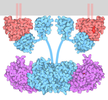





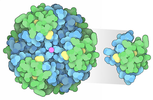

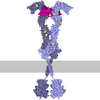




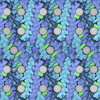
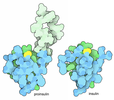



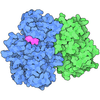
 Z (Sec.)
Z (Sec.) Y (Row.)
Y (Row.) X (Col.)
X (Col.)




































